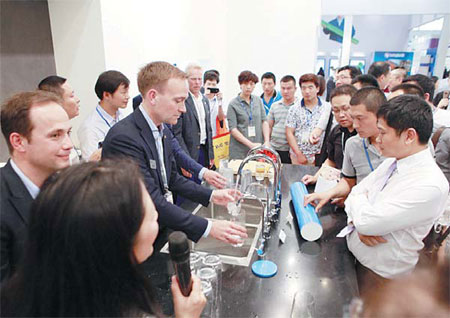For a drink of clean water, turn on the tap
|
Niclas Wullt, general manager of Bluewater, demonstrates the effect of the water purifiers produced by the Swedish company. Provided to China Daily |
Unlike air purifiers, which are an integral part of many Chinese households, water purifiers are still relatively unknown products for most Chinese consumers. But that may soon change as growing concerns about water safety are prompting more Chinese consumers to turn to such products, creating a robust platform for overseas companies to showcase their products.
Bluewater, a Sweden-based water purifier maker, is one of the companies that is looking to make a mark in China with its top-end maximizer products that come with global quality assurances.
According to a recent study published by China Market Monitor, the size of the Chinese water purifier market was estimated to be about 9.5 billion yuan ($1.5 billion) last year. The study indicates that the market will grow by 80 percent this year.
But the real game-changer for most companies comes from reports that indicate that more than one-third of China's drinking water sources are polluted and unfit for consumption.
According to data published by the Chinese Center for Disease Control and Prevention, in 2011, only 61 percent of the water from major Chinese rivers was in category I to III, the desired level for safe drinking water. The report also pointed out that most of the pipes and other equipment used for transporting water in China are outdated and need urgent replacement.
"Guaranteeing a proper water supply is still a major concern in most rural areas. But raising awareness about water quality is a new mission that we have to undertake seriously now," says Bai Xuetao, deputy director of the environment and heath department of the disease control and prevention center.
"Since smog is visible, people purchase air purifiers quickly. However, water pollution is hard to detect, and there is not much awareness about the quality measures. People react only when there are reported instances of water pollution," he says.
In Europe and the US, more than 90 percent of families have water purifying equipment installed at home, while in China it is less than 5 percent, says the China Market Monitor study.
"The space under the sink (where the water purifier is usually installed) in most families means big market potential for us," says Niclas Wullt, general manager of Bluewater, a brand owned by Blueblue AB, a privately-owned company in Sweden.
"Our studies have shown that most Chinese consumers will leave no stone unturned in their quest for clean, safe water. We are looking to fill that niche with our top-end water purifiers."
Explaining the brand preferences, Wullt says of Chinese consumers:"If they like BMW, they buy the most expensive model with the best configuration. They have a similar attitude toward their kitchen also."
Though the maximizer was launched only last year in Sweden, its sister brand, the Blueair air purifier, is already a well-known product in the air purifier market.
Wullt says the entry-level Bluewater purifier costs 15,000 yuan while the top-end model "Bluewater Pro" costs 60,000 yuan. Most of the Chinese-made water purifiers are priced below 10,000 yuan, he says.
"Our target customers are the well-off customers who focus more on health, rather than the money - especially middle-class parents who want the best for their children," says Wullt. "If we can demonstrate that our products will make the difference, then it is not hard to sell them."
Looks also matter, he says, adding that unlike many other brands, the Bluewater purifiers look more like a compact box than bulky machines.
Most of the Chinese home appliance makers have already launched water purifiers. A report from consultancy firm AVC shows that domestic brands like Haier and Midea accounted for over 80 percent of the market last year. Another major foreign brand, A. O. Smith, said it sold about 140,000 water purifiers in China last year, and estimates the number to reach 220,000 this year.
Wullt says that Bluewater will not resort to price cuts or discounts to grow market share. Instead, he says, the company will bank on growing demand from high-end Chinese customers.
There are three major technology approaches for water purifier companies, he says. These are reverse - osmosis, activated carbon and water softening technologies. Both Bluewater and A. O. Smith have adopted reverse - osmosis technology, as studies indicate that it can filter 99 percent of the pollutants from tap water.
Water purifiers made with this technology account for 35 percent of the market, and have outperformed machines in other categories, says the China Market Monitor study.
The main advantage of the top-end Bluewater model is that it is more efficient, its makers say. While a regular purifier extracts one liter of purified water from five liters, the top-end model extracts one liter from 1.7 liters of water, Wullt says.
Bluewater will initially focus on Beijing and Shanghai before moving on to other Chinese cities, he says, adding that the company has 15 dealerships in Europe and five in the US.
Contact the writers through wangchao@chinadaily.com.cn.



















